The Department of Medical Genetics and Rare Orthopaedic Diseases in collaboration with Laboratory CLIBI, launched 4 Disease Registries for rare hereditary diseases that are currently active:
Definition of the Registry
In a 1974 World Health Organization publication, Brooke delineated registries in health information systems as "a file of documents containing uniform information about individual persons, collected in a systematic and comprehensive way, in order to serve a predetermined purpose".
(M. Brooke - 1974 - World Health Organisation)
Definition of disease Registry
"A disease registry is an organized system that uses observational study methods to collect uniform data (clinical and other) to evaluate specified outcomes for a population defined by a particular disease, condition, or exposure, and that serves one or more predetermined scientific, clinical, or policy purposes".
(Agency for Healthcare Research and Quality - 2014 - Registries for Evaluating Patient Outcomes: A User's Guide. 3rd edition).
The aim of the Disease Registries
Disease registries aim to investigate the natural history of a specific condition (or of small groups of diseases) in order to increase knowledge and understanding in an area lacking reliable and solid information. These registries are therefore intended for epidemiological and natural history studies, but also for other research activities such as, for example, studies intended to correlate genetic background and clinical signs.
In addition, disease registries aim to contribute to the creation of a broad dataset of patients with mulitple final objectives, like:
- to raise awareness of the investigated disease
- to facilitate the diagnosis pathway
- to respond to the pending epidemiological questions
- to identify homogeneous patient groups in which carry out genetic correlations
- to improve the quality of treatment and care
- to perform research studies on aetiopathogenesis and development of new therapeutic strategies.
The Establishment of REM, ROI, RED and ROM Registries
The implementation of the REM, ROI, RED and ROM registers was performed on a step-by-step basis. At first, since March 2003, the Medical Genetic Department started a data collection, gathering information on patients, during day clinic activities.
To facilitate standardized data collection, in 2005, with the support of regional funding an IT platform was set up to guide the different healthcare professionals in collecting standardized data. This platform was then implemented and optimised with additional regional funding in 2008. Subsequently, all 4 registers were assessed and approved by the Ethics Committee. Recently, aiming to improve the IT platform and to comply with current national and European regulations, a new platform, named GeDI, Genotype-phenotype Data Integration Platfrom, has been realized.

Safety of data collected
The entire set of processes governing the registries is strictly regulated. In fact, REM, ROI, RED and ROM have been all approved by the Ethics Committee of the Istituto Ortopedico Rizzoli and the collection of the data is carried out only after seeking the participants’ informed consent. Personal data, according to European and national legislation, are pseudonymised (processed in such a manner that they can no longer be attributed to a specific subject without the use of additional information, that is kept separately), so as to ensure that such personal data are not attributed to an identified or identifiable natural person.
As the Registries and the stored data are valuable, we wanted to rely on cybersecurity. The implementation of the GeDI — Genotype-Phenotype Data Integration Platform, in use since February 2019, has been crucial for ensuring security and stability of participants’ information. Data are encrypted and securely stored in accordance with current legislation (Regulation (UE) 2016/679 – GDPR; Italian Legislative Degrees no. 101/2018 and no. 196/2003).
